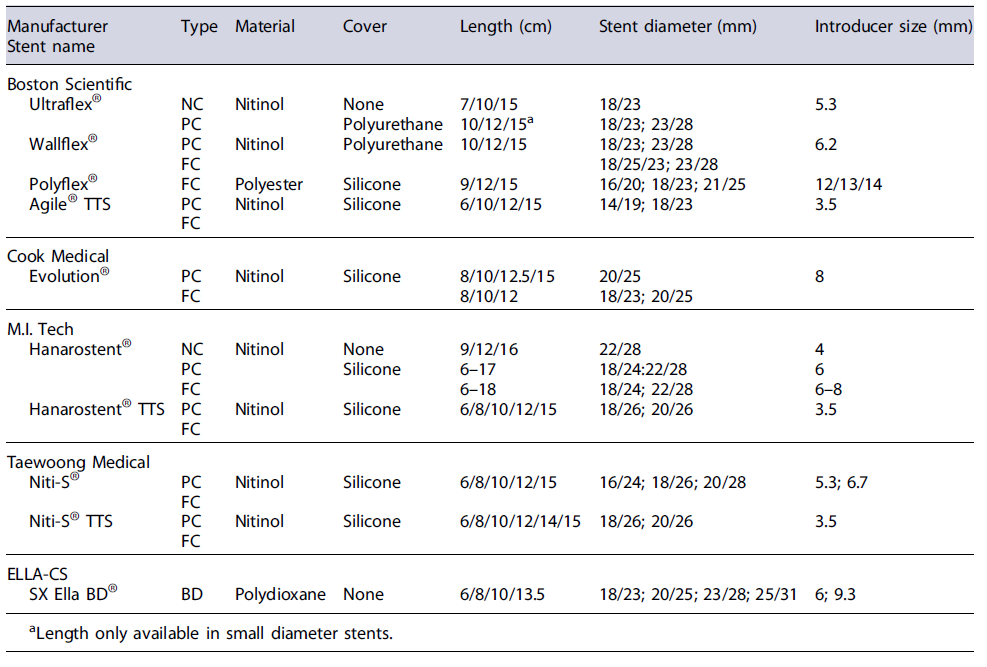History of Esophageal Stents
The current acceptable origin of the word stent is that it derives from the name of a dentist, Charles Thomas Stent (1807-1885) who was an English dentist notable for his advances in the field of denture making. He developed a formula made of gutta-percha, a plastic substance made from a Malaysian tree called percha tree used for filling a tooth after a root canal procedure. The etymological origin of “stent” as a term in surgery started with Johannes F. Esser in 1917, which used Stent’s dental compound as a mold for bridging skin grafts [1]. The term “stent” became popular among surgeons for such applications and was then later used to define any surgical mold for bridging tissues until a healing process has taken place, as in 1954, when Remine and Grindlay described the use of a polyethylene tube as “to act as a stent for the anastomosis” in experimental biliary surgery [2]. In gastroenterology, Molnar and Stockum in 1974 were the first to use the term stent to describe a percutaneous transhepatic catheter used to relieve an obstructive jaun-dice [3] and, in 1980, Nib Soehendra and Reynders-Frederix described the endoscopic placement of a biliary stent for the palliation of a malignant biliary obstruction [4]. Since then, this latter procedure has become the preferred method to relieve jaundice and improve quality of life for patients with advanced malignant biliary obstruction.
Gastrointestinal (GI) stents have been originally used to treat obstructing cancer in the GI tract. From early modern medicine in the 19th century until nowadays, GI tract cancer or luminal palliation has always been a huge challenge for surgeons and physicians. In esophageal cancer, for example, there were multiple nonsurgical attempts to relieve dysphagia. In 1845, James Leroy d’Etoilles, a French surgeon, was the first to treat malignant dysphagia with a tube made out of ivory, without success [5]. A few years later in 1885, Charters James Symonds performed the first successful esophageal stenting procedure by using an esophageal semirigid tube with a proximal funnel attached to a silk suture which was brought out of the mouth and attached to the patient’s ear, providing adequate nutrition and palliation, while also improving quality of life [6]. Subsequently, considerable advances have been made and further technical developments included the use of a stent introducer over a guide wire technique, the direct endoscopic insertion, and the use of several materials like latex or silicone to increase softness of the stents without the need for external fixation, such as the Celestin® and the Wilson-Cook® tubes [7, 8]. However, these esophageal stents, originally designed as rigid or semirigid, cylinder-like prostheses, while being the best palliation measure at that time, avoiding surgery, had poor efficacy and high adverse event rates, such as migration, obstruction, and perforation of the GI tract [9].
Self-Expandable Metal Stents
The concept of placing a self-expandable metal stent (SEMS), inserted through a small diameter delivery system which conform to the GI tract angulations, has been borrowed from the cardiovascular setting. In fact, the first SEMS to be inserted in the esophagus were two 20 mm endovascular Wallstents® in patients with inoperable esophageal cancer [10]. The use of SEMS has allowed additional anatomical areas to be bypassed, decreased the risks associated with placement of relatively large diameter plastic tubes, and has expanded our ability to palliate and effectively treat a wide variety of GI disorders. According to several randomized controlled trials, the use of SEMS was associated with significantly reduced stent-related adverse events when compared to plastic prosthesis, with better palliation of dysphagia, shorter hospital days, and longer survival [11, 12]. To this extent, their development and application has been nothing short of revolutionary, quickly replacing plastic prosthesis as the method of choice in the treatment of malignant dysphagia and, to a lesser extent, refractory benign esophageal strictures and GI tract fistulas, leaks, and perforations.
Actual SEMS differ considerably in their properties as defined by the material used, their shape, the mesh stent pattern, and the type and design of the cover that surrounds the stent mesh (Table 1). These different characteristics and designs may ultimately influence stent choice and clinical outcome since, despite several decades of evolution, there is no ideal stent type to date that fits all cases. That would be one with a reliable and simple stent deployment system, good visibility on fluoroscopy, radial force high enough to allow a good expansion but without causing pain or pressure necrosis, high flexibility and conformability around angulations and flexures of the GI tract, resistance to obstruction and migration but with the ability to be easily removed if necessary. Nevertheless, the specific implications of the different stent characteristics on clinical outcome are not completely understood due to the lack of high-level evidence from head-to-head comparisons in randomized clinical trials.
Stent Materials and Construction
The materials used in stent design are of utmost importance to the successful function and lifetime of the device. This structural material must be biocompatible, have sufficient elasticity so as to be compressed for loading into the tubular delivery system, and able to exert sufficient radial force upon expansion to re-establish patency of the esophageal lumen [13]. Currently, self-expandable stents may be manufactured from two materials, polymer or metal.
The two polymer stents commercially available until recently were the Polyflex® (Boston Scientific) and the SX Ella BD® (ELLA-CS). Polyflex® was developed in 2003 and was a SEPS - self-expandable plastic stent, made of woven plastic polyester strands and fully covered with a silicone membrane. In malignant setting, SEPS became an alternative to SEMS with comparable efficacy in palliation of advanced esophageal carcinoma [14, 15]. Furthermore, due to its full coverage and less granulation tissue reaction, it was easily removed endoscopically and it was the only FDA approved stent for benign indications. Other indications for their use were the removal of uncovered or partially covered SEMS thorough a stent-in-stent technique and the increase of the radial force that helps to achieve full expansion of previously deployed SEMS [16]. However, SEPS did not come preloaded and the delivery system was significantly larger and rigid, requiring preinsertion dilation up to 15 mm. SEPS also had a high radial expansion force, causing chest pain, and was more prone to migration as they were fully covered [17, 18]. Due to this high risk of adverse events, the production of the Polyflex® has been terminated.
traditional push-pull deployment system, enabling accurate placement of the stent. While Ultraflex® only has its rectosigmoid counterpart (the over-the-wire Ultraflex Precision®), the Evolution® system has a family of stents to treat not only esophageal but also gastroduodenal, biliary, and colonic strictures. Similarly, Boston Scientific also has the Wallflex® family of nitinolmade stents encompassing the GI tract, with a “soft” version for gastroduodenal and colonic locations.
However, the elastic properties of the SEMS are pro-vided not only by nitinol itself but also from a combination of the material with the construction of the stent. There are laser cut stents, with very high radial force and lower foreshortening, usually less than 10%, thus allowing for more accurate deployment [23]. However, these stents are very rigid, with a high axial force [24]. The axial force is considered to be the force that a stent exerts to straighten when it bends along the longitudinal axis. If the axial force is too high, the stent will exert strong forces to straighten its shape. As a result, they will have less flexibility, not conform well to anatomic flexures and hold an increased risk of causing excessive pressure and trauma to the esophageal wall [25]. This laser cut stents differ from the woven wirebraided or knitted configuration. In the braided stents, the nitinol wires cross over each other but do not interlock. They have a high radial force and, although being more flexible, that configuration retains a relativity high axial force specially when coated, due to the restriction of the movement of the wires by the silicone dipping, heightening the risk of kinking on flexion [26]. In addition, braided stents shorten significantly upon expansion, thus being less predictable when deployed. In the knitted design stents, the wires hook around each other like a wire fence within the stent structure that allows the stent wires to displace not only laterally but also in a longitudinal fashion, resulting in a stent with low axial force and high flexibility [24, 27]. Knitted stents conform well to anatomical flexures, such as the gastro-esophageal junction, and have the ability to absorb compressive forces and adapt to esophageal peristalsis, being more likely to stay in place and avoid migration [13]. Although knitted stents tend to have a lower radial force than braided ones, they retain the ability to expand into the original diameter and configuration [24].
Stent Covers
The original esophageal SEMS were mostly uncovered, which allowed for good embedding into the tumor and surrounding esophageal tissue, ensuring good anchorage and reducing the risk of migration. However, uncoated stents are prone to tissue hyperplasia and tumor ingrowth through the stents interstices, eventually leading to new stricture or obstruction [28].
To overcome these adverse events, a variety of polymers like polyethylene, polyurethane, and silicone have been used for stent coating. While polyurethane and external silicone are prone to mechanical damage and early degradation in an acidic environment, expanded polytetrafluoroethylene is less elastic but when applied as an external membrane provides a more durable barrier against tumor ingrowth [13].
Fully covered stents avoid stent embedding and prevent tissue ingrowth, also preventing the extravasation of secretions and ingested oral content when a GI leak is present [29]. They are endoscopically retrievable and increasingly being used not only for palliation of malignant dysphagia but also off-label in the setting of benign esophageal diseases like strictures, perforations, and leaks since they can be placed for extended periods of time without embedment. Nevertheless, they should be kept in place no more than 12 weeks since tissue hyperplasia may still occur at the stent margins due to friction during peristalsis [30]. However, those advantages came with the trade-off of an increased risk of migration, which may lead to recurrent dysphagia or, in case of leaks and leaks, incomplete sealing of the defect [29, 31]. Furthermore, in the latter context, fully covered stents adhere less well to the esophageal wall, allowing the passage of luminal content in the space between the stent and the esophageal wall.
A compromise is presented by partially covered stents, designed to improve stent patency, where several millimeters of the stent ends are left bare to achieve mucosal fixation, minimizing migration, while most of the middle is covered, providing a partial barrier against ingrowth [32]. Additionally, embedded flanges of par-tially coated SEMS provide optimal sealing of leaks and fistula to divert luminal contents, reducing leakage between the stent and the esophageal wall [33]. This is particularly relevant in critically ill patients with anastomotic leaks after upper GI surgery where the insertion of a partially covered SEMS may play a crucial role as a quick, safe, and effective treatment. Although they are generally retrievable up to 1 or 2 weeks after placement, the longer dwell times needed in these cases (up to 8 weeks) often require either the obliteration of the tissue ingrowth in the uncovered portions near the edges of the stent with argon plasma coagulation or the insertion of a second high radial force fully covered stent (a Polyflex® was used in the original description) inside the first one. After a period of 10-14 days, the inner stent is extracted, and an attempt at removing the original stent can be made. Under fluoroscopy, a therapeutic scope and two foreign body grasping forceps (a rat tooth for the lasso loop and an alligator jaw for the metallic mesh) are used to invert inward the upper flange of the stent (and if necessary also the lower one) until it dislodges from the esophageal wall, using afterward the purse string lasso loop to remove it. This technique, known as “stent in stent,” should only be attempted by experienced operators, ideally using a combination of endoscopy and fluoroscopy to assess stent mobilization and to reduce the risk of perforation [34].
Stent Size
The size of the stent is another variable to be con-sidered and that can influence outcomes. Larger diameter stents are usually desirable as they aim to establish maximal luminal diameter, reducing and delaying the risk of reobstruction by luminal ingrowth, while providing optimal sealing of leaks and fistula to divert luminal contents [35, 36]. They are also recommended in settings associated with an increased risk of migration such as extrinsic compressions, location at the gastro-esophageal junction or esophagojejunal anastomosis, or when there is no stricture, like in fistula and leaks. The trade-off is a higher incidence of chest pain, usually during the first 24-48 h but sometimes persisting beyond the early post-procedural period, mainly in tumors previously submitted to radiotherapy [37]. Furthermore, the use of largest ents should be avoided in the smaller proximal esophageal lumen or when there is any tracheal compression by the tumor [38]. If there is tumor extension into the airway occluding more than one-third of the tracheal lumen, a tracheal stent must be inserted first. Rare cases of anastomotic leak enlargement have also been described with the use of high radial force large diameter stents [39].
The length of the stent should be enough to allow the 1.5-2cmflanges to surpass the tumor. An exception to this rule is stent placement in the most proximal esophagus, where the stent flange should not be positioned too far proximally into or across the upper esophageal sphincter. However, as long as a flexible small diameter, low radial force stent is used, it may be left immediately below the cricopharyngeus, there will be no risk of aspiration or patient intolerance. Likewise, stents crossing the gastro-esophageal junction should be at least 12 cm long, so they may anchor in the esophagus, and no more than 1.5 to 2 cm of stent should be left below the tumor and free in the stomach, in order to avoid distal migration and the impaction of the stent on the opposite gastric wall [40, 41]. In patients with high risk of stent migration, the use of a novel over-the-scope clip device (stentfixOTSC®)manufactured by Ovesco Endoscopy significantly reduced stent migration rate compared with that without stent fixation, with no or few adverse events related with clip application or removal [42].
Insertion Technique
Precise placement of SEMS in the esophagus is relatively straightforward and generally easier than stent placement in other locations. Adequate patient sedation is mandatory for these procedures as coughing and patient movement during stent insertion can result in misdeployment. The first step is to perform an upper endoscopy to define the proximal and distal margins of the malignant stricture or lesion. However, the stricture is oftentimes very tight or difficult to allow the passage of a standard gastroscope. In those cases, several endoscopic maneuvers like luminal suction, rotation of the endoscopic insertion tube, locking the angulation control knobs, and stiffening of the endoscopic tip with a forceps or metallic guide wire should be attempted. If, despite all efforts, the gastroscope cannot pass through the stricture, there are several options: contrast may be injected under fluoroscopy to delineate the lesion, a pediatric upper endoscope may be used, or the stricture may be dilated.
Although aggressive dilation should be avoided since it may increase the risk of perforation, dilation up to a maximum diameter of 11 mm with a bougie is quite safe. That will permit a standard endoscope to pass beyond the tumor with the advantage of allowing the full evaluation not only of the stricture characteristics and length but also of the rest of the upper GI tract. Moreover, it will also allow the use of an endoscopic clip to mark the margins of the lesion for fluoroscopic visualization since most clipping fixing devices are not compatible with the working channel of the pediatric upper endoscopes. Precise marking is of utmost importance mainly when there is a small margin of error like in the proximal cervical esophagus, where the stent should be positioned immediately below the cricopharyngeus, when there is the need to seal a leak or fistula or even in the cardia, where no more than 1.5 to 2 cm of stent should be left free in the stomach, as previously mentioned. Additionally, in some delivery systems like the Ultraflex®, the stent is tied down to the outside of the delivery catheter by a silk thread, which makes the system bulky and externally rough, resulting in the highest need for predilation. After passing the gastroscope through the stricture, the margins of the area to be stented should be marked with two endoclips, namely in the middleesophagus or incase of largeleaks wherewewantto center the stent, or with only one endoclip in lesions of the cardia or near the upper esophageal sphincter, where there is a one-sided narrower margin of error. A metallic stainless steel guide wire (Savary-Gilliard®, Cook Medical) is then left in place with the tip in the second part of the duodenum or looping in the antrum, and the endoscope is removed. The use of a stiff guide wire allows for a greater support and stability, especially when placing a floppy stent delivery system distally in the esophagus or gastroesophageal junction. If a metallic guide wire is not available, another option is to use an extra
stiff 0.035″ guide wire like the Lunderquist® (Cook Medical). In very narrow and complex strictures difficult to negotiate, you may use a guide wire with ahydrophilictiplike the Jagwire® Stiff Shaft (Boston Scientific) eventually with the help of a three lumen, dual port cannula Tandem® XL (Boston Scientific) for simultaneous contrast injection.
Stent Selection
There are a wide variety of stent designs that are commercially available in current practice, each with its purported advantages and limitations. Since there is no ideal stenttypetodatethat fits all cases, achieving expertise with different models will aid physicians in selecting the optimal SEMS for a given condition. In my personal experience, stent flexibility is the most important feature in stent selection that should be taken into consideration as I believe that the incidence of complications like migration and pressure necrosis can be reduced with increased flexibility. Worldwide, Ultraflex® is one of the most commonly used stents for treatment of malignant dysphagia. This stent, made of knitted nitinol, has a central cover of polyurethane and has uncovered ends at the proximal and distal 15 mm stent ends. It is available in two diameters (18-mm body/23-mm proximal flare and 23-mm body/28-mm proximal flare) and in both proximal and distal release delivery systems. It is mounted with a long thread that holds the compressed stent. The end of the thread is pulled through the catheter lumen to the opposite end of the catheter and tied to a plastic ring. The stent is released by pulling the thread (Fig. 1). After expansion, it foreshortens up to 30-40%, which makes precise stent placement difficult [9]. Moreover, although there are four radiopaque markers in the delivery system (the inner two markers indicating the final position of the covered part of the deployed stent and the outer two, the position of the uncovered portion), these markers are not very reliable and some experience is needed for accurate positioning. The main advantage of the Ultraflex® is its axial force being the lowest among the currently availables tents, which makes it soft and flexible [25]. That better conformability to the esophageal wall and angulations allows for a reduced migration rate, less pressure necrosis, and a better sealing of GI leaks [43]. The latter, along with the benefitofhaving the distance from the upper margin of the stent to the incisors depicted on the introducer system, allows for its placement in patients with anastomotic leaks in intensive care units without the need for fluoroscopic guidance [44]. The proximal release small diameter Ultraflex® is also the ideal stent to be inserted in high strictures close to the upper esophageal sphincter, since it allows a more precise control of the stent position during expansion, while the distal release large diameter one is most suitable for placement across the gastro-esophageal junction [13] (Fig. 2, 3).
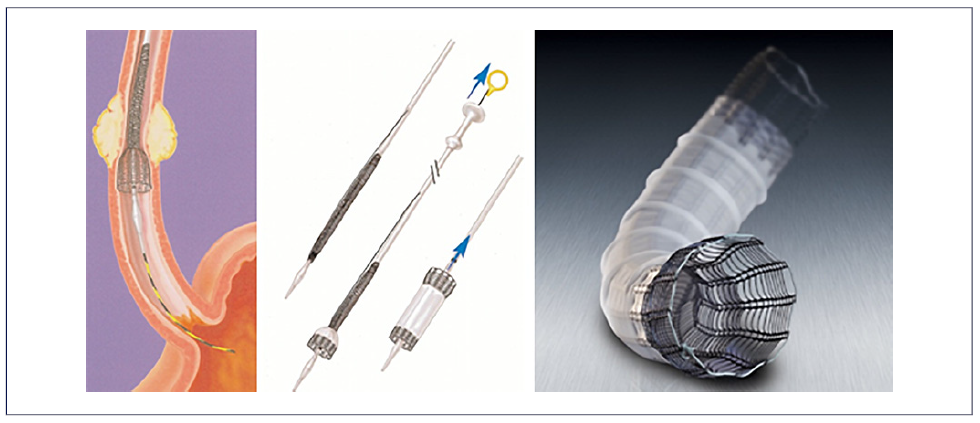
Fig. 1 Illustration of the delivery system of the Ultraflex® esophageal stent. Arrows indicate how to release the stent by pulling out the string. Note the green suture at the proximal end for stent repositioning.
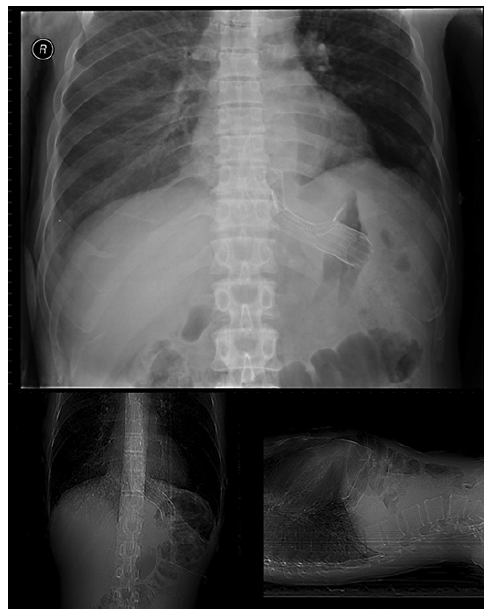
Fig. 2 Radiologic and CT scout appearance of the Ultraflex® stent placement across the gastroesophageal junction. Higher flexibility allows better conformability in anatomically challenging areas like GI angulations, reducing the risk of pressure necrosis and migration.
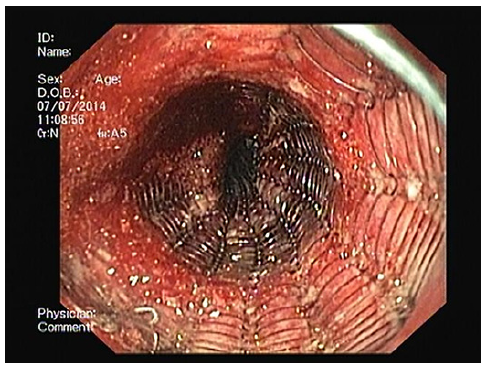
Fig. 3 Endoscopic view of the partially covered Ultraflex® esophageal stent immediately after deployment.
The Evolution® (Cook Medical) is a braided mesh stent that is made from a single woven, nitinol wire. These stents have an internal and external silicone coating in order to prevent ingrowth and recurrent dysphagia. The internal stent cover also precludes adherence of fibrous food to the stent mesh. Two different versions are available: a partially covered with 20 mm uncovered distal and proximal flares and a fully covered version. The stent is available in lengths varying from 8 to15 cm and abody diameter of 20mm with flanges of 25 mm and is placed with a pistolgrip delivery system which allows controlled release and recapturing, if needed. The braided construction and the silicone encasement of the stent mesh allows for a higher expansion force than the Ultraflex®, making it ideal for placement in strictures with a large tumor bulk or surrounding fibrosis in the midesophagus [26, 45](Fig. 4). In addition, the fully covered version of the stent also has a repositioning lasso loop in both ends, making it easily retrievable. This fully covered stent is most suitable for placement as the inner stent in the “stent-in-stent” technique, as explained above, or when there is recurrent malignant dysphagia due to tumor progression and overgrowth at the proximal or distal stent ends. In the latter, a second fully covered stent is placed through the first stent, adequately covering the site of tumor overgrowth. Endoscopic clipping may be used to fix this stent to the mesh of the previous one, avoiding the risk of stent migration. With this technique, we take the advantage of the full coverage to resist tissue ingrowth and reduce episodes of recurrent dysphagia without the disadvantage of a higher risk of stent migration.
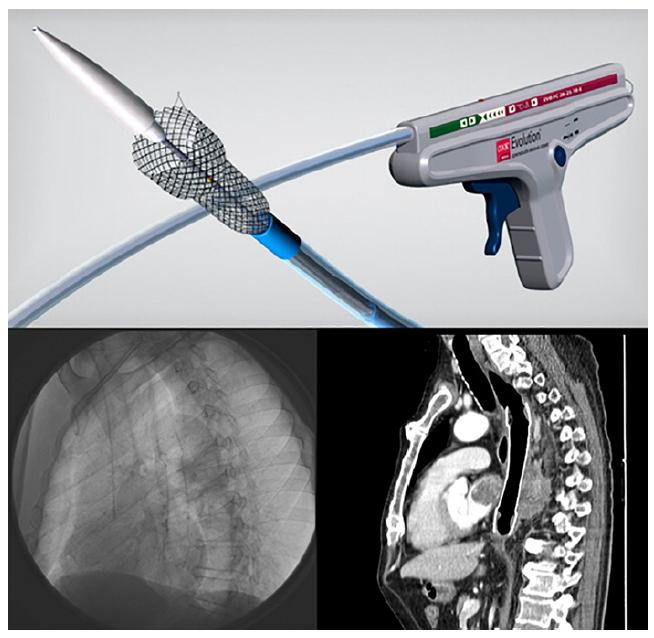
Fig. 4 Evolution® Controlled Release Esophageal Stent System. Radiologic and CT view after deployment in a case of extrinsic esophageal compression caused by an obstructive pulmonary cancer.
Table 2 shows an overview of clinical success and adverse events with esophageal SEMS placement for malignant and benign indications. Although there is a relatively high risk of adverse events, most of these are minor and can be prevented or managed endoscopically, like stent migration and tissue in- or overgrowth. The minor adverse event rates are comparable between malignant and benign indications. Observed major complications included esophageal perforation, hemorrhage, and pneumonia due to aspiration. Innovations requiring further evaluation and validations studies include radioactive stents, with improved dysphagia grades and median survival in patients treated with I-125 loaded stents [46], and drug eluting stents with bi- or multilayer configuration for localized delivery of various drugs like paclitaxel or 5-fluorouracil, these still with no clinical data in humans [47, 48].
Table 2 Overview of clinical success and adverse events with esophageal SEMS placement for malignant and benign indications
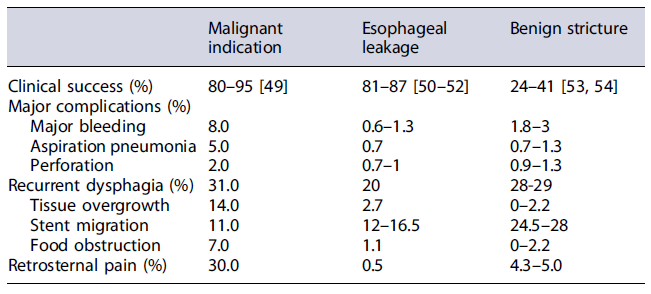
Although the initial stent selection has a significant impact on the clinical outcome in patients with inoperable malignancy, there are no data to date demonstrating significant differences in outcomes or complications among SEMS types. Most evidence is of low grade, based on case series or small comparative studies. Therefore, the choice of specific SEMS has been based on availability and endoscopist’s preference and experience. Better understanding of the factors affecting stent performance and a more individualized approach to each patient should be adopted in order to choose between the multiple stenting options.














